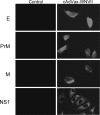Complex adenovirus-mediated expression of West Nile virus C, PreM, E, and NS1 proteins induces both humoral and cellular immune responses
- PMID: 17634508
- PMCID: PMC2043313
- DOI: 10.1128/CVI.00070-07
Complex adenovirus-mediated expression of West Nile virus C, PreM, E, and NS1 proteins induces both humoral and cellular immune responses
Abstract
West Nile Virus (WNV), a member of the family Flaviviridae, was first identified in Africa in 1937. In recent years, it has spread into Europe and North America. The clinical manifestations of WNV infection range from mild febrile symptoms to fatal encephalitis. Two genetic lineages (lineages I and II) are recognized; lineage II is associated with mild disease, while lineage I has been associated with severe disease, including encephalitis. WNV has now spread across North America, significantly affecting both public and veterinary health. In the efforts to develop an effective vaccine against all genetic variants of WNV, we have studied the feasibility of inducing both neutralizing and cellular immune responses by de novo synthesis of WNV antigens using a complex adenoviral vaccine (CAdVax) vector. By expressing multiple WNV proteins from a single vaccine vector, we were able to induce both humoral and cellular immune responses in vaccinated mice. Neutralization assays demonstrated that the antibodies were broadly neutralizing against both lineages of WNV, with a significant preference for the homologous lineage II virus. The results from this study show that multiple antigens synthesized de novo from a CAdVax vector are capable of inducing both humoral and cellular immune responses against WNV and that a multiantigen approach may provide broad protection against multiple genetic variants of WNV.
Figures






Similar articles
-
Humoral and cellular immune response to a single dose of a novel bivalent recombinant adenovirus-vector vaccine against West Nile virus and chikungunya virus in mice.Virol J. 2025 Jul 25;22(1):256. doi: 10.1186/s12985-025-02878-5. Virol J. 2025. PMID: 40713773 Free PMC article.
-
A plant-produced vaccine protects mice against lethal West Nile virus infection without enhancing Zika or dengue virus infectivity.Vaccine. 2018 Mar 27;36(14):1846-1852. doi: 10.1016/j.vaccine.2018.02.073. Epub 2018 Feb 26. Vaccine. 2018. PMID: 29490880 Free PMC article.
-
A single immunization with a minute dose of a lentiviral vector-based vaccine is highly effective at eliciting protective humoral immunity against West Nile virus.J Gene Med. 2006 Mar;8(3):265-74. doi: 10.1002/jgm.837. J Gene Med. 2006. PMID: 16308885
-
Mapping and analysis of West Nile virus-specific monoclonal antibodies: prospects for vaccine development.Expert Rev Vaccines. 2007 Apr;6(2):183-91. doi: 10.1586/14760584.6.2.183. Expert Rev Vaccines. 2007. PMID: 17408368 Review.
-
Technologies for the development of West Nile virus vaccines.Future Microbiol. 2014;9(10):1221-32. doi: 10.2217/fmb.14.67. Future Microbiol. 2014. PMID: 25405890 Review.
Cited by
-
Humoral and cellular immune response to a single dose of a novel bivalent recombinant adenovirus-vector vaccine against West Nile virus and chikungunya virus in mice.Virol J. 2025 Jul 25;22(1):256. doi: 10.1186/s12985-025-02878-5. Virol J. 2025. PMID: 40713773 Free PMC article.
-
Bioinformatics in new generation flavivirus vaccines.J Biomed Biotechnol. 2010;2010:864029. doi: 10.1155/2010/864029. Epub 2010 May 10. J Biomed Biotechnol. 2010. PMID: 20467477 Free PMC article.
-
A complex adenovirus-vectored vaccine against Rift Valley fever virus protects mice against lethal infection in the presence of preexisting vector immunity.Clin Vaccine Immunol. 2009 Nov;16(11):1624-32. doi: 10.1128/CVI.00182-09. Epub 2009 Sep 23. Clin Vaccine Immunol. 2009. PMID: 19776190 Free PMC article.
-
A complex adenovirus vaccine against chikungunya virus provides complete protection against viraemia and arthritis.Vaccine. 2011 Mar 24;29(15):2803-9. doi: 10.1016/j.vaccine.2011.01.108. Epub 2011 Feb 12. Vaccine. 2011. PMID: 21320541 Free PMC article.
-
Vaccines in development against West Nile virus.Viruses. 2013 Sep 30;5(10):2384-409. doi: 10.3390/v5102384. Viruses. 2013. PMID: 24084235 Free PMC article. Review.
References
Publication types
MeSH terms
Substances
Grants and funding
LinkOut - more resources
Full Text Sources
Other Literature Sources
Medical

